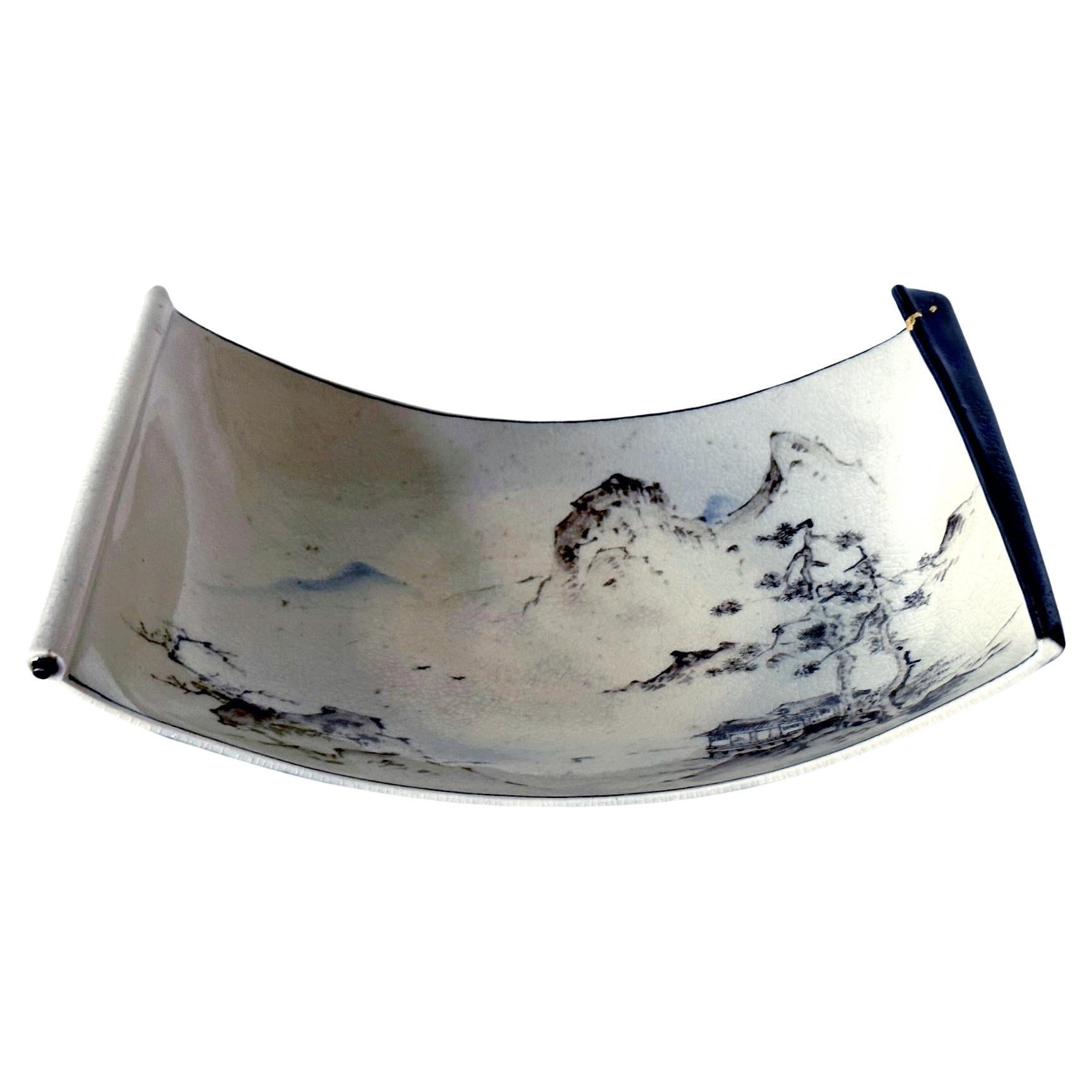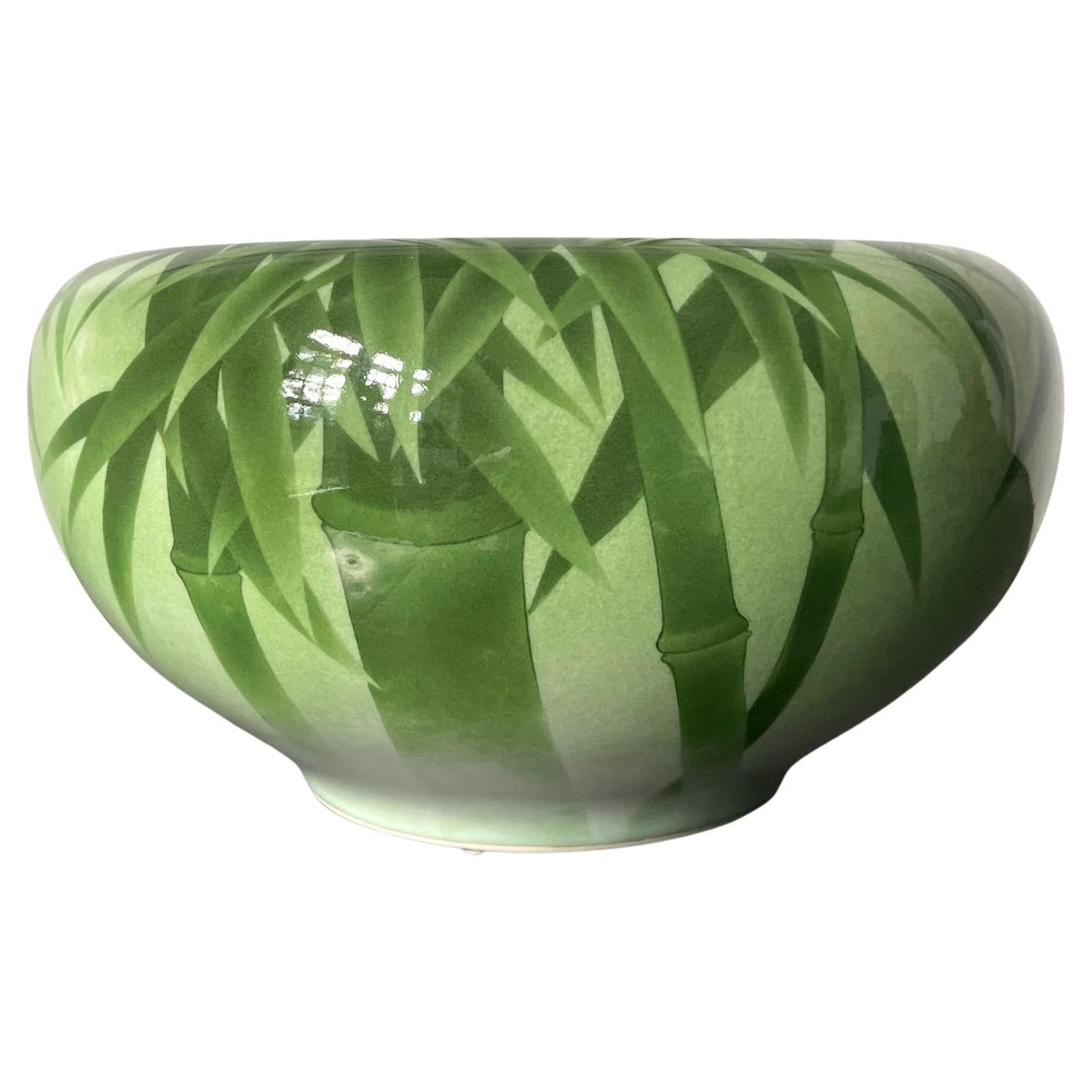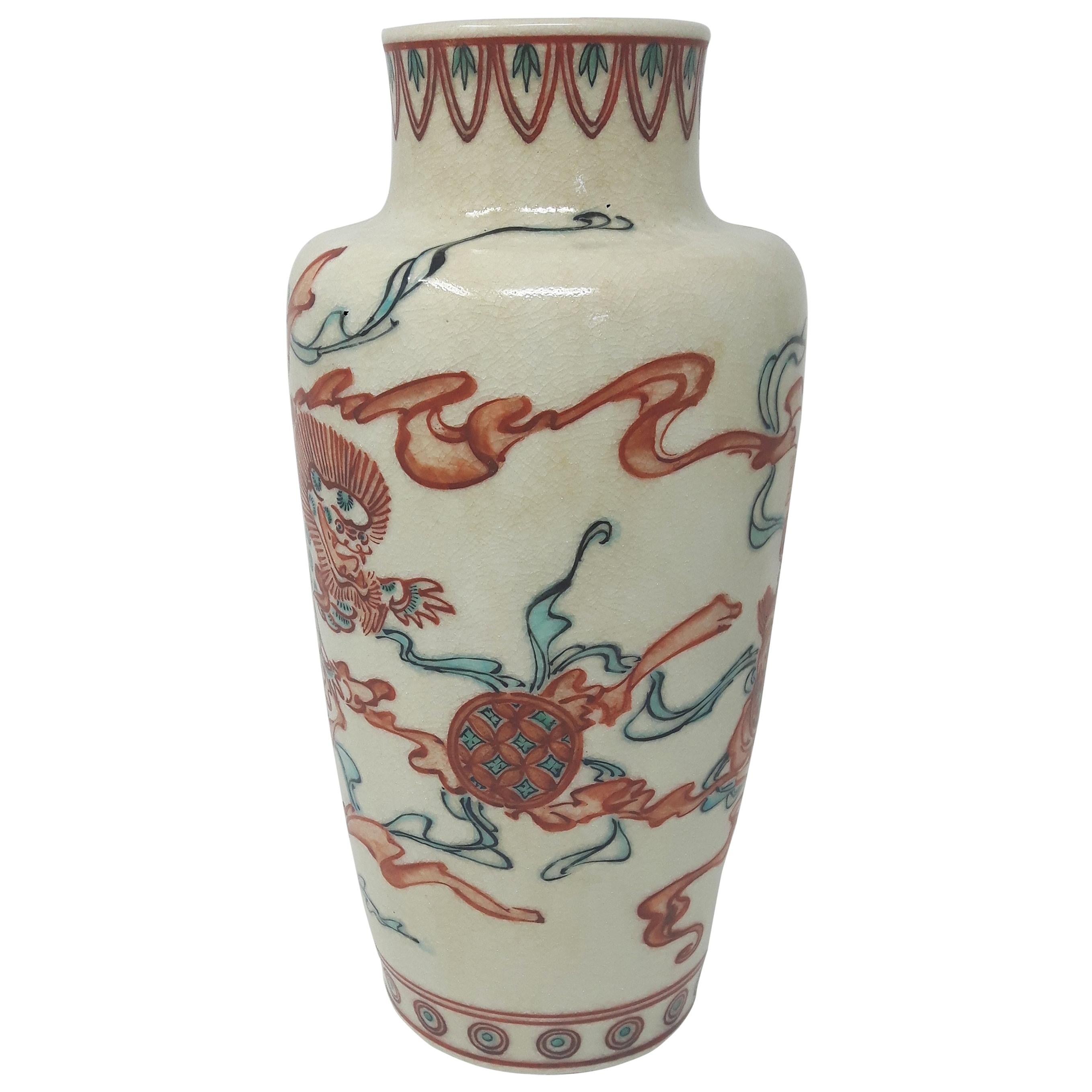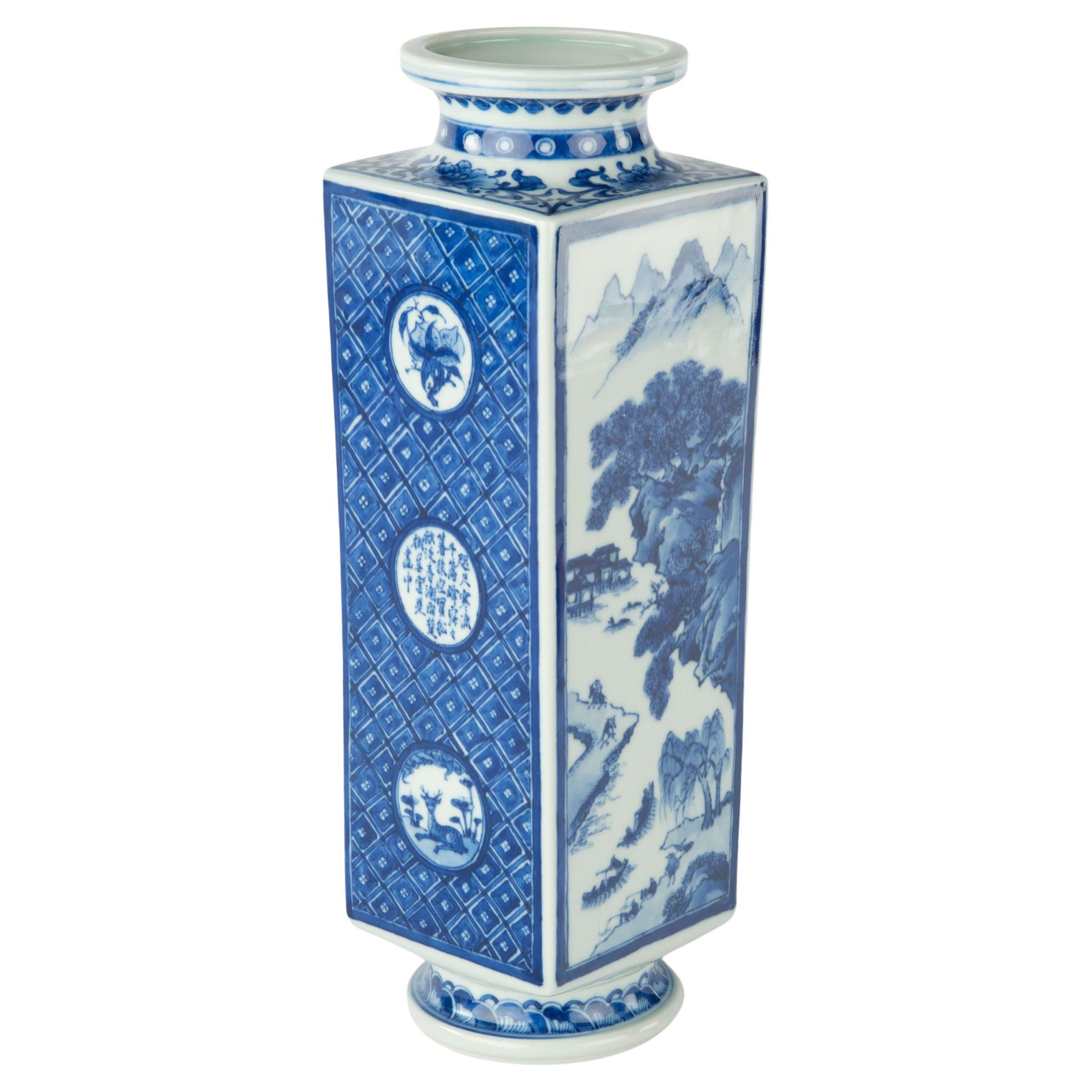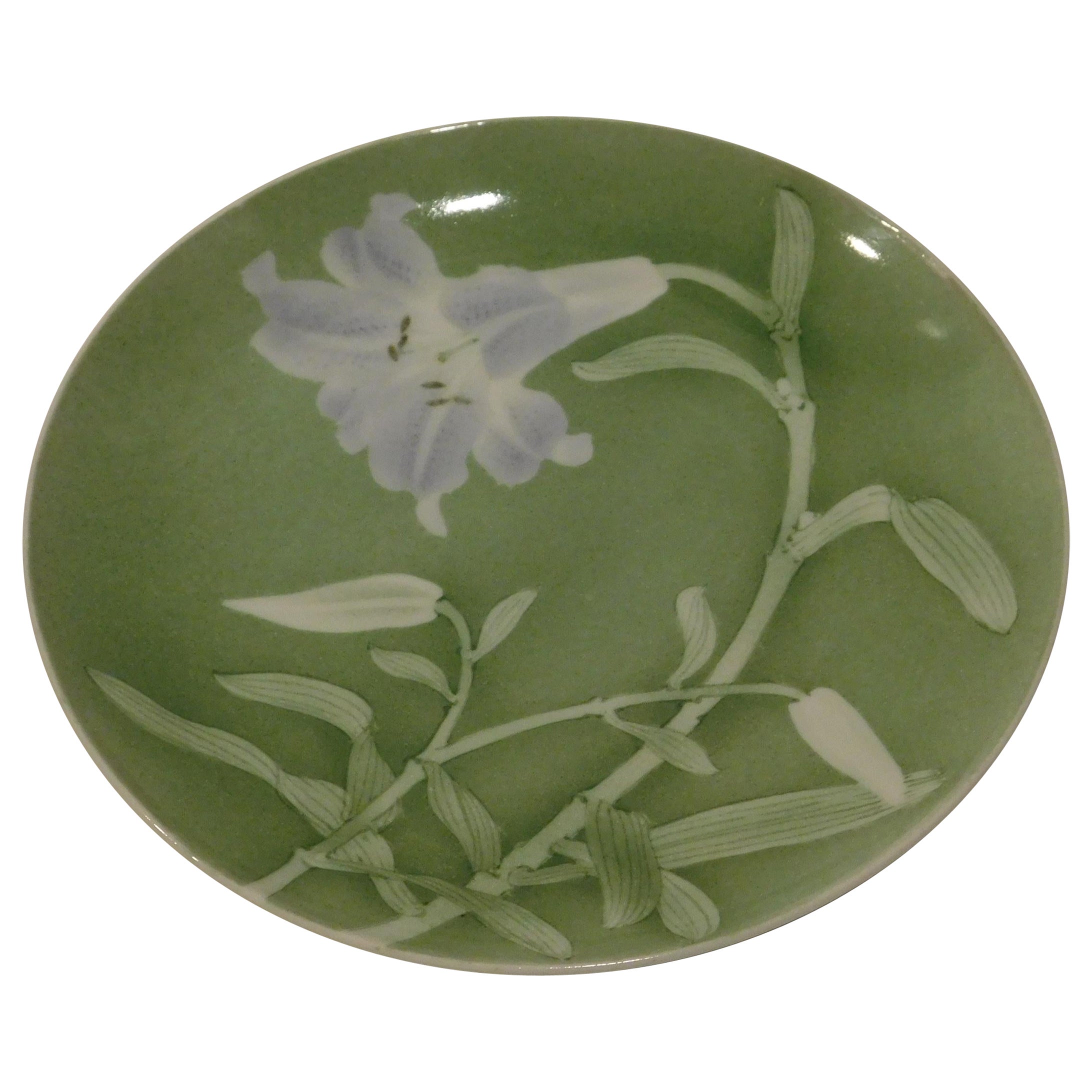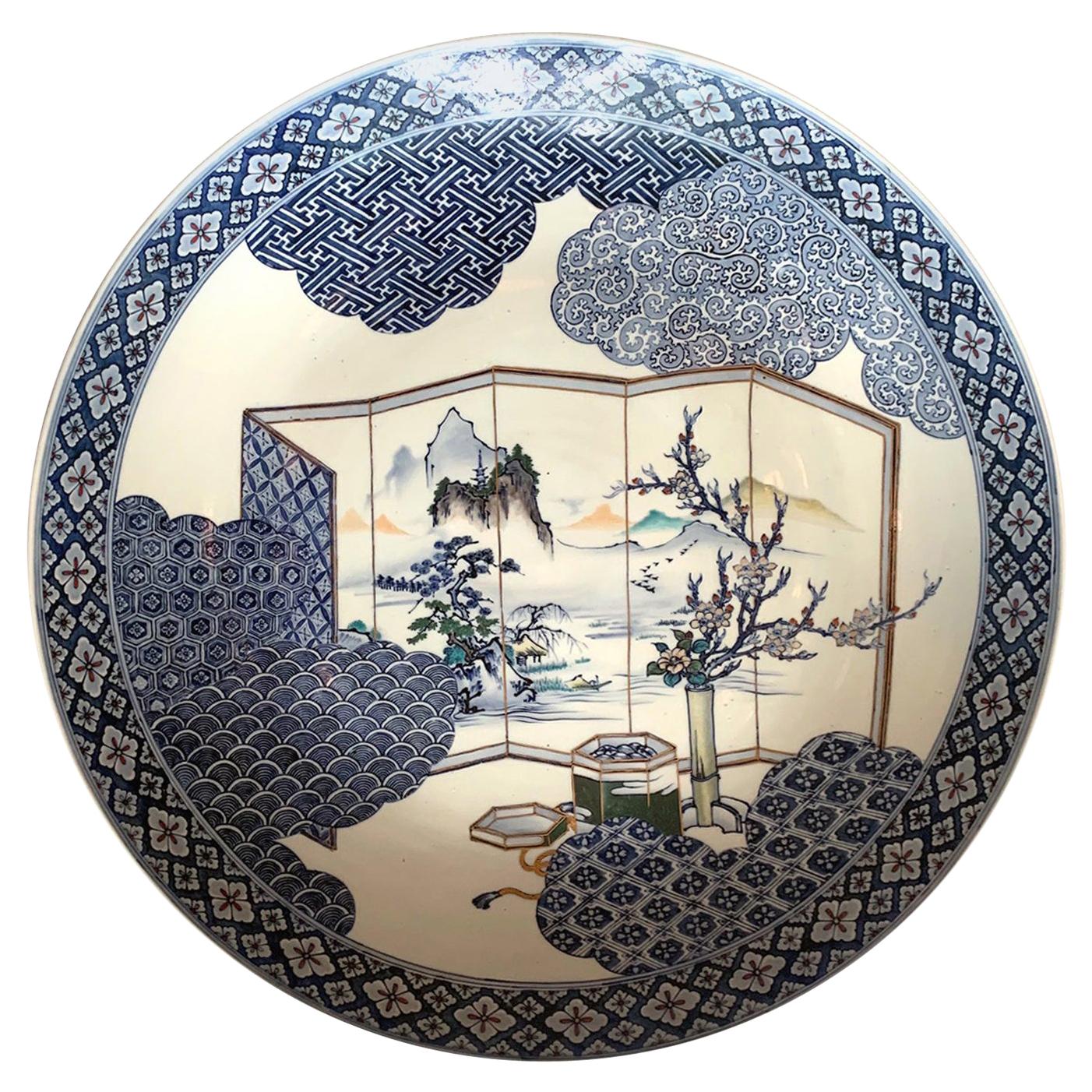Items Similar to Rare Large Japanese Porcelain Presentation Plate Makuzu Kozan
Want more images or videos?
Request additional images or videos from the seller
1 of 21
Rare Large Japanese Porcelain Presentation Plate Makuzu Kozan
About the Item
A large presentation plate with striking pictorial design from the studio of Japanese Potter Makuzu Kozan. Also known as Miyagawa Kozan (1842–1916), Makuzu was one of the most established ceramists from Meiji Period. Born as Miyagawa Toranosuke, Kozan established his pottery studio in Yokohama around 1870s and later became one of the appointed artists to the Japanese Imperial household. His work was exhibited in many international fairs that the Meiji government participated at the turn of the century and won many grand prizes.
With an impressively size of 15 inch in diameter, this plate was likely made as a presentation piece for one of the expositions the studio participated in the early 20th century (This is also indicated by the signature on the bottom, see later). The surface was decorated with underglaze cobalt blue and a variety of shades in iron brown, using the novel technique developed by Kozan called Fuki-e (the blow painting) to achieve the striking dimensional effect. Being one of the most creative ceramists, Kozan started experimenting with new chemical colors from the West in the format of his porcelain glaze around 1880s. New colors allowed him to create underglaze designs that appeared bright, smooth and glossy. He even invented his own receipt of cobalt blue to achieve a much brighter yet softer shade, as evident on the grasses depicted on this vase. The fuki-e technique was demanding and uniquely featured in the works of Kozan studio.
Showcasing a striking composition of three flying geese in vivid motion, the artist rendered each bird with a unique composure yet together they form a harmonious and graphic-like picture. Beneath them, the tall grasses in blue glaze swayed in the wind. The fuzzy fibers on the tip of the stalks and the subtle serrated edges, undoubtfully suggest the season of fall, the time for the birds' southern-bound migration. The masterful use of the shades of the same color is breathtaking, as if the artist was painting on canvas instead of ceramic. The painterly quality, clearly at its Zenith, and the Ambience it evokes, call to mind the work of Ohara Hoson (1877-1945), a contemporary Japanese painter and woodprint designer who was part of the Shin-Hanga movement. It was not unusual during that exciting period when new ideas and techniques were exploding in the society, the artists who gained vision from Western Art, inspired each other's work, albert on totally different medium. The plate was signed underneath in an artist's archaic style seal, the specific detail of which help to date it to Meiji 37th to Taisho 5th (1904-1916). Works with these types of archaic seals were believed made mostly for oversea exhibitions during 1900-1920s and they were the best examples of Kozan's studio work that bridged the East and the West.
For a group of large exhibition pieces by Makuzu Kozan bearing the same seal in the Khalili Collection, see Oliver Impey et al., The Nasser D. Khalili Collection, vol.5, Ceramics, part I: Porcelain, London, Kibo Foundation, 1995, cat nos. 35-45.
.
- Creator:Makuzu Kozan (Artist)
- Dimensions:Height: 2.1 in (5.34 cm)Diameter: 15 in (38.1 cm)
- Style:Meiji (Of the Period)
- Materials and Techniques:
- Place of Origin:
- Period:
- Date of Manufacture:1904-1916
- Condition:Wear consistent with age and use. Fine antique condition with a spot on the base not covered by the glaze, which appears to occur during the making process. A small chip on the inner edge of the base ring as shown.
- Seller Location:Atlanta, GA
- Reference Number:1stDibs: LU945033493782
About the Seller
5.0
Platinum Seller
These expertly vetted sellers are 1stDibs' most experienced sellers and are rated highest by our customers.
Established in 2006
1stDibs seller since 2010
479 sales on 1stDibs
Typical response time: <1 hour
- ShippingRetrieving quote...Ships From: Atlanta, GA
- Return PolicyA return for this item may be initiated within 2 days of delivery.
More From This SellerView All
- Rare Japanese Porcelain Painted Footed Dish Makuzu KozanBy Makuzu KozanLocated in Atlanta, GAA rare footed dish in the form of an open scroll painting with literati landscape from the studio of Japanese Potter Makuzu Kozan. Also known as Miyagawa Kozan (1842–1916), Makuzu wa...Category
Antique Early 1900s Japanese Meiji Ceramics
MaterialsPorcelain
- Rare and Large Japanese Porcelain Vase Makuzu KozanBy Makuzu KozanLocated in Atlanta, GAA striking blue and white vase from the studio of Japanese Potter Makuzu Kozan, also known as Miyagawa Kozan (1842–1916), one of the most established and collected ceramist from Meiji Period. Born as Miyagawa Toranosuke, Kozan established his pottery studio in Yokohama around 1870s and later became one of the appointed artist to the Japanese Imperial household. His work was exhibited in many international fairs that the Meiji government participated at the turn of the century and won many grand prizes. With an impressively large size, this vase was likely made and reserved as a presentation piece for one of the many expositions the studio participated in the early 20th century. It was decorated with underglaze cobalt blue using the novel technique developed by Kozan called Fuki-e (the blow painting), in order to achieve the striking dimensional literary landscape known as "Mountain and Water". Being one of the most creative ceramists, Kozan started experimenting with new chemical colors from the West in the format of his porcelain glaze around 1880s. New colors allowed him to create underglaze designs that appeared bright, smooth and glossy. He even invented his own receipt of cobalt blue to achieve a much brighter yet softer shade, as evident on this vase. To create landscape that is realistic and dimensional, more common in the western paintings, he was inspired by the native Japanese ink painting technique developed around 1900 by Yokoyama Taikan...Category
Early 20th Century Japanese Japonisme Ceramics
MaterialsPorcelain
- Japanese Ceramic Centerpiece Bowl Makuzu Kozan Meiji PeriodBy Makuzu KozanLocated in Atlanta, GAA beautiful ceramic vessel in the form of Bo, the so-called monk's alms bowl from the studio of Japanese Potter Makuzu Kozan, also known as Miyagawa Kozan (1842–1916), one of the most established and collected ceramist from Meiji Period. Born as Miyagawa Toranosuke, Kozan established his pottery studio in Yokohama circa 1870s and later became one of the appointed artists to the Japanese Imperial household. His work was exhibited in many international fairs that the Meiji government participated at the turn of the century and won many grand prizes. Of a relatively large size, this piece was made as a decorative center piece for display. It was brilliantly decorated with underglaze paint of a green-on-green bamboo motif, using the novel technique developed by Kozan called Fuki-e (the blow painting). As a result, the bamboos appear took on a three-dimensional quality as if appearing in a mist. Known as one of the most creative ceramists, circa 1887, Kozan started experimenting with new chemical colors from the West in the format of his porcelain glaze. New colors allowed him to create underglaze design that appeared bright, smooth and glossy. To create design that is realistic and dimensional, more common in the western paintings, he was inspired by the native Japanese ink painting technique developed around 1900 by Yokoyama Taikan...Category
Antique Early 1900s Japanese Japonisme Ceramics
MaterialsCeramic
- Rare Japanese Porcelain Incense Burner with Inlays Makuzu KozanBy Makuzu KozanLocated in Atlanta, GAA porcelain incense burner (koro) made by Japanese potter Makuzu Kozan (also known as Miyagawa Kozan, 1842-1916) circa 1890s-1900s (end of Meiji Period). The koro features an elegant...Category
Antique Late 19th Century Japanese Meiji Ceramics
MaterialsCeramic
- Japanese Porcelain Vase Meiji Period Makuzu KozanBy Makuzu KozanLocated in Atlanta, GAA finely decorated and glazed Japanese porcelain vase by Makuzu Kozan (1842-1916) circa 1900s Meiji Period. The vase is of a classic bottle form with baluster body and short neck. It was decorated with underglaze white magnolia blossom on a pleasant celadon background. The stamens of the flower were artistically rendered in a low relief, giving the design a realistic appeal with the dimension. Miyagawa Kozan...Category
Early 20th Century Japanese Meiji Ceramics
MaterialsPorcelain
- Japanese Porcelain Vase Makuzu Kozan Meiji PeriodBy Makuzu KozanLocated in Atlanta, GAA striking blue and white vase from the studio of Japanese Potter Makuzu Kozan, also known as Miyagawa Kozan (1842–1916), one of the most established and collected ceramist from Meiji Period. Born as Miyagawa Toranosuke, Kozan established his pottery studio in Yokohama circa 1870s and later became one of the appointed artists to the Japanese Imperial household. His work was exhibited in many international fairs that the Meiji government participated at the turn of the century and won many grand prizes. Of a relatively large size, this vase is decorated with underglaze cobalt blue using the novel technique developed by Kozan called Fuki-e (the blow painting). As a result, the bamboos appear took on a three-dimensional quality as if appearing in a mist. Known as one of the most creative ceramists, circa 1887, Kozan started experimenting with new chemical colors from the West in the format of his porcelain glaze. New colors allowed him to create underglaze design that appeared bright, smooth and glossy. He even invented his own receipt of cobalt blue to achieve a much brighter yet softer shade, as evident on this vase. To create landscape that is realistic and dimensional, more common in the western paintings, he was inspired by the native Japanese ink painting technique developed around 1900 by Yokoyama Taikan...Category
Antique Early 1900s Japanese Japonisme Ceramics
MaterialsCeramic
You May Also Like
- Unusual Early 20th Century Makuzu Kozan VaseBy Makuzu KozanLocated in London, GBDecorated in iron-red and green enamels with an overall design of three shish frolicking with a brocade ball, signed on the base with an impressed seal Makuzu. The storage box ti...Category
Early 20th Century Japanese Meiji Ceramics
MaterialsPorcelain
- Large Japanese Ceramic Vase by Makuzu KozanLocated in Christchurch, GBAs part of our Japanese works of art collection we are delighted to offer this tapering square form Meiji Period 1868-1912, ceramic vase from the studios of the highly coveted Imperi...Category
Antique 19th Century Japanese Ceramics
MaterialsCeramic
- Makuzu Kozan Modern Japanese Ceramic TrayBy Makuzu KozanLocated in Phoenix, AZBeautiful pale green ceramic tray featuring white lilies. It is signed on the base by Miyagawa (Makuzu) Kozan (1842-1916). This tray has no damage and is in perfect condition. It me...Category
Antique Late 19th Century Japanese Ceramics
MaterialsCeramic
- Japanese Porcelain Charger finely Hand Painted, Meiji Period circa 1880Located in Lincoln, LincolnshireThis is a good quality, hand decorated Japanese porcelain charger, large plate or bowl with an Imari pattern, dating to the late 19th centur...Category
Antique Late 19th Century Japanese Meiji Ceramics
MaterialsPorcelain
- Japanese Meiji Period Satsuma Large Square Bowl CenterpieceBy SatsumaLocated in Vero Beach, FLJapanese Meiji Period Satsuma large square bowl Antique early Meiji Period 15" square with scalloped rim Satsuma bowl. Highly unusual and finely painted. ...Category
Antique 19th Century Japanese Meiji Ceramics
MaterialsCeramic
- Late 17th Early 18th Century Nabeshima Japanese Porcelain Plate Fruit DesignLocated in Milano, ITDish with karatuuri (melon) design Late 17th-early 18th century Porcelain decorated with cobalt blu underglaze and red fruits Diameter 15.2 cm Nabeshima ware was made at Okawachi near Arita in Kyushu under the authority of the Nabeshima clan. The feudal lords of Nabeshima were so proud of their technological skill, that throughout the Edo period (1615-1867) they gave porcelain (and swords) as presents to the lords of other provinces. Most of Nabeshima porcelain...Category
Antique Late 17th Century Japanese Ceramics
MaterialsPorcelain
Recently Viewed
View AllMore Ways To Browse
Large Japanese Art
Presentation Piece
Large Japanese
Japanes Rare
Japanese Rare
Japanese Porcelain
Japanes Porcelain
Japanese Plate
Japan Plate
Japan Plates
Japanese Works Of Art
Japanese Furniture Designer
Large Japanese Late
Japanese Inspired Furniture
Japan Soft
Japanese Antique Other Japanese Antiques
Collection Of Rare Plates
Porcelain Shades
